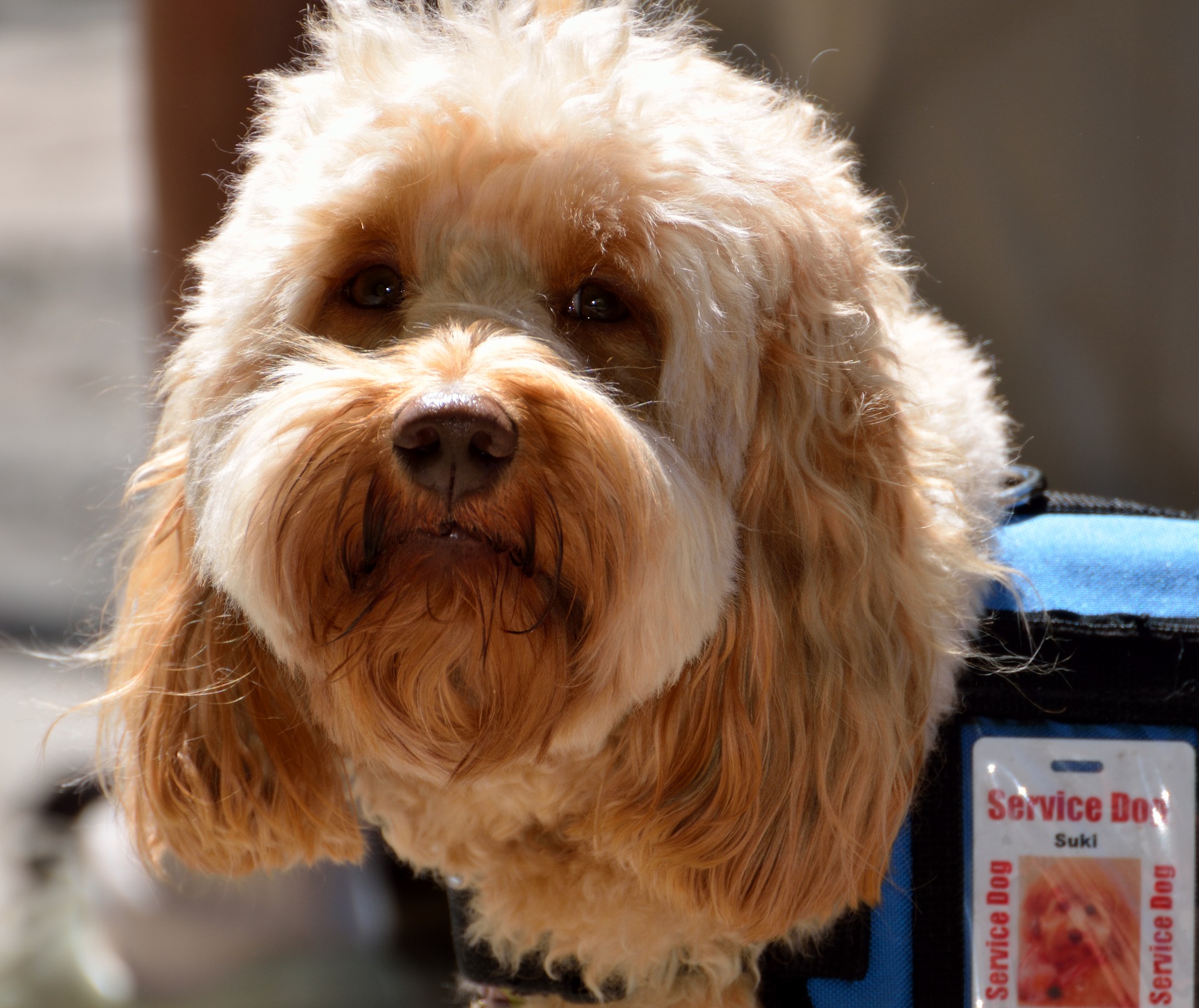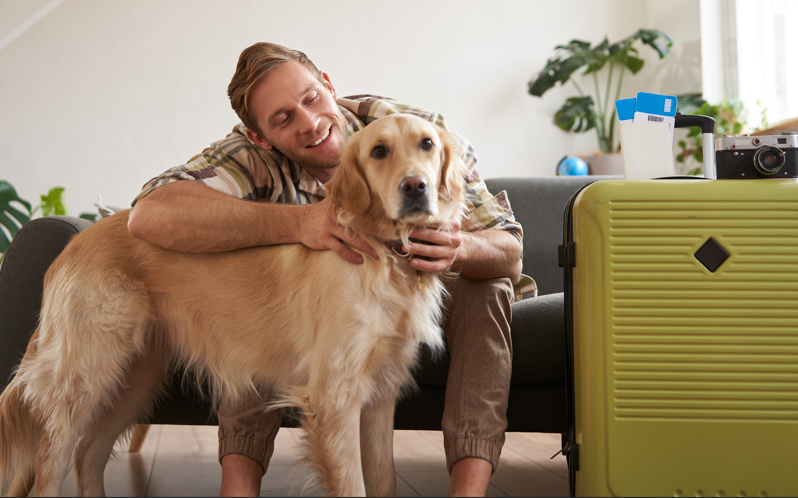- Are Psychiatric Service Dogs the Same As Emotional Support Animals?
- Do You Need a Medical Diagnosis to Get a Psychiatric Service Dog?
- Where to Get a PSD
- Can Every Dog Become a Psychiatric Service Dog?
- Best PSD Breeds
- Health Requirements
- Do You Need to Register or Certificate Your PSD?
- Do You Need to Spay/Neuter Your PSD?

Psychiatric Service Dogs (PSD) are dogs individually trained to perform tasks for the benefit of people with different kinds of mental disabilities like PTSD, panic attacks, anxiety, stress, depression. PSD can be trained to perform a variety of tasks including Deep Pressure Stimulation, retrieving medication, opening the door, preventing panic attacks in public, providing tactile stimulation...etc.
Are Psychiatric Service Dogs the Same As Emotional Support Animals?
The PSDs are considered service animals and they must be granted all public access rights that service dogs have. It is important to note that psychiatric service dogs are not emotional support animals, hence both terms are different. ESAs are not deemed service animals, as they are not trained to perform specific tasks. Hence they do not have the public access rights that service dogs have.
If you or your family member/friend are dealing with mental illnesses and are wondering if you are eligible for a Psychiatric Service Dog we will be happy to help you and take a detailed look at this topic.
Do You Need a Medical Diagnosis to Get a Psychiatric Service Dog?
The Federal Government defines “disability” as follows:
“For the purposes of federal disability nondiscrimination laws (such as the Americans with Disabilities Act (ADA), Section 503 of the Rehabilitation Act of 1973 and Section 188 of the Workforce Innovation and Opportunity Act), the definition of a person with a disability is typically defined as someone who (1) has a physical or mental impairment that substantially limits one or more "major life activities," (2) has a record of such an impairment, or (3) is regarded as having such an impairment”.
Considering the definition above it is being understood, that an individual must have a letter issued by a medical professional with a diagnosis about their mental illness. If you suffer from:
Post-Traumatic Stress Disorder (PTSD), Obsessive-Compulsive Disorder, Generalized Anxiety Disorder, Depression, Schizophrenia, Agoraphobia, Panic Attacks, Bipolar Disorder,
you may get a Psychiatric Service Dog and train him to perform tasks, according to your particular needs.
We need to note that such a letter may or may not be required from public facilities that you may want to visit accompanied by your dog. Service dogs in the US are a subject of the ADA regulations and according to ADA:
“Staff are not allowed to request any documentation for the dog, require that the dog demonstrate its task or inquire about the nature of the person's disability”.
However, if any airline representatives doubt the legitimacy of your service animal, they are allowed to require such a letter as additional verification. Otherwise, you need to provide them with two documents only-
-U.S. Department of Transportation Air Transportation Service Animal Training and Behavior Attestation Form;
-U.S. Department of Transportation Service Animal Relief Attestation Form (Relief Form) (for flights scheduled to take 8 hours or more).
Once you are provided with a letter by your psychiatrist or another medical professional, you need to think about the ways you can get a PSD.
Where to Get a PSD
There are different organizations that provide trained Psychiatric Service Dogs.
If you choose a training organization to get a PSD, you may need to pay a lot of money (thousands of dollars). A psychiatric service dog's cost may vary depending on the organization that you contact. The average cost for a psychiatric service dog for anxiety or depression runs between $20,000 to $30,000.
There are many non-profit organizations that provide service dogs, including Psychiatric Service Dogs. However, there are waiting lists and you may need to wait for 1-2 or more years to get one.
Many breeders recommend that owners train their own dogs to become Psychiatric Service Dogs. The reason for that is the bond that has been created between handler and dog. The stronger this bond is the easier the dog will recognize the symptoms of his/her handler, as well as their handler’s emotional state, and will be able to respond to it better. Once you send your dog away to get trained you “jeopardize” your bond, which is one of the most essential factors for dogs do be good Psychiatric Service Dogs. Moreover, no program can fully cover all your needs and requests.
However, in some cases owners are unable to conduct proper training, i.e. their physical state might not allow it, they may not have the time, the skills, and the patience for that. Moreover, you can be confident that a professionally trained dog is likely to have all the necessary skills.
If you think that you can not train your own dog due to different reasons you need to decide whether you would like to get a rescued animal from a shelter (usually at adult age) that has been trained or a puppy that has been trained from a young age. Both options have advantages as well as disadvantages. By getting a dog from a shelter, you give him/her a second chance. In most cases shelter dogs are even more loyal, they will love their savior unconditionally, and once they start to trust them the bond created between dog and handler will be really strong. Moreover, the adoption cost will be beneficial for the shelter. Through the adoption fees, shelters are able to take care of the dogs better. Of course, you need to pay attention to factors like the emotional baggage that the dog may have. Many shelter dogs have had a miserable life and need time to trust humans again. Hence you will need to be extremely patient and give your furry friend the time he/she needs to adapt. The older a dog becomes the more difficult will be for him/her to learn new skills. On the other hand, puppies are more flexible and adaptive and can be trained in all the necessary skills quicker.
You need to remember that regardless of the option you choose- training by a professional trainer or yourself, you will need to maintain the training. Once your dog obtains the necessary skills to help you in your daily life and alleviate your symptoms, you will need to keep practicing with your canine all the learned tasks.
Can Every Dog Become a Psychiatric Service Dog?
In order to be a good service dog, a dog should be naturally friendly and eager to please its owner, be intelligent, enjoy learning new skills and be trainable. Service dogs should not be aggressive towards people or other animals and not behave disruptively. So, it is crucial for a good PSD to have a stable temperament and to not get easily distracted. Too lazy or hyperactive dogs are not good options. In the first case, the dog may not be interested in physical or mental exercises, in the second case you constantly may need to figure out games, exercises and your dog may be unable to calm you down and mitigate your symptoms when needed.
Best PSD Breeds
There are some breeds considered very suitable as Psychiatric Service Dogs due to their temperament.
These are the Labrador and the Golden Retrievers, the Poodles, the Havanese, the Miniature Schnauzer, the Cavalier King Charles Spaniel, the German Shepherd, and more. The most common features between these dogs are their friendly and easy-going temperament and their loving nature. These dogs are intelligent and attached to their owners. We need to say that ADA does not restrict the type of dog breeds that can be service animals and is considered a violation of the ADA regulations of a service dog that has been denied public access due to his/her breed only.
As stated at the beginning of the article Psychiatric Service Dogs are service animals and business owners must grant them access rights to their establishments. Handlers can not be required to provide documentation as proof of the legitimacy of the animal. However, owners are permitted to ask two questions:
1. Is the animal a service animal due to a disability;
2. What tasks he/she has been trained to perform;
Here comes the main difference between a PSD and an ESA. Psychiatric Service Dogs need to provide specific tasks and their handlers may be required to point them out.
Health Requirements
Once you get a service dog you need to ensure that he/she is in a good health. Regular veterinarian visits will be needed. During international flights or some domestic flights, depending on the local regulations you may be required to provide the airline with your service dog’s full vaccination records. This means that you will need to track your canine’s vaccination record. The age of 6 months is considered the age when a dog can be recognized as a service animal. The age of 10-12 years is deemed a retirement age. You need to be careful when conducting training if you have a too young or too old dog since their bones might get hurt easily. Evaluate the pressure during the training process so that your canine will not be overwhelmed with too demanding physical tasks. Always keep the sessions short and remember to motivate your dog with treats and toys. You need to avoid mental pressure as well and never force your dog so that he/she does not get stressed.
Do You Need to Register or Certificate Your PSD?
ADA does not require service dogs to be registered or certified.
“Covered entities may not require documentation, such as proof that the animal has been certified, trained, or licensed as a service animal, as a condition for entry”.
However, if your local state laws require all animals to be registered this applies to service animals as well.
“Q19. My city requires all dogs to be registered and licensed. Does this apply to my service animal?
Yes. Service animals are subject to local dog licensing and registration requirements”.
Do You Need to Spay/Neuter Your PSD?
There are no regulations that require service dogs to be neutered/spayed. However, many trainers recommend sterilization of service animals as they will become calmer and female dogs will not be distracted by male dogs during their heat period. Since service dogs are working animals they need to stay focused on their handler’s needs. Moreover, the training will be easier and your dog is not likely to show mounting, dominating behavior, or roam.














